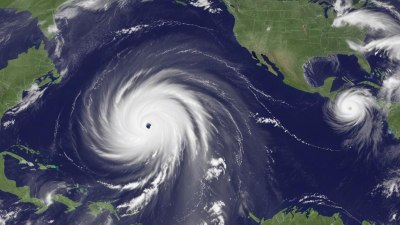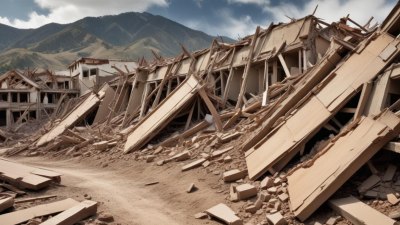How Hibernation Mode Turns You Into a Passive Cold Front
Explore how hibernation mode slows your body and mind, mimicking a passive cold front, impacting energy and activity.

Hibernation is a fascinating biological process that some animals use to survive harsh winter months, dramatically lowering their metabolic rate to conserve energy. While humans do not truly hibernate, the concept of "hibernation mode" is often used metaphorically to describe periods when people become lethargic, less active, and perhaps emotionally withdrawn, much like a passive cold front slowly sweeping across the landscape. This article explores how entering a hibernation mode affects your physical, mental, and emotional states, translating that into a natural phenomenon—the cold front—and what it means for your overall well-being.
Understanding Hibernation: The Biological Perspective
Firstly, it’s essential to distinguish between true biological hibernation and the colloquial use of the term. True hibernation occurs primarily in certain mammals like bears, bats, and ground squirrels, where the animal’s body temperature, heart rate, and metabolic processes reduce drastically. This metabolic suppression conserves energy during times when food is scarce and temperatures are low. It’s a survival mechanism, finely tuned through evolution, allowing these animals to endure months with minimal caloric intake.
During hibernation, the animal’s body enters a state of torpor, greatly reducing physiological activities. Heart rates drop from hundreds of beats per minute to just a few, body temperature falls close to the ambient temperature, and breathing slows significantly. This state is not simply sleep; it’s a complex shutdown of biological systems that allows for extended periods of inactivity without the typical risks of muscle atrophy or organ failure. After the hibernation period, the animal reawakens, usually in spring, with its biological mechanisms ramping back up to normal functioning.
"Hibernation Mode" in Humans: A Metaphor for Low Energy States
Humans do not hibernate in the scientific sense. However, the phrase "hibernation mode" is often used to describe temporary phases of low energy, reduced motivation, or social withdrawal. It can be triggered by seasonal changes, stress, illness, or mental health challenges like depression or seasonal affective disorder (SAD). During these periods, individuals might feel the urge to rest more, avoid physical or social activity, or experience difficulties in concentration and productivity.
This metaphorical hibernation is akin to a "passive cold front" in meteorology, where a large mass of cooler air moves slowly and steadily across an area, leading to a drop in temperature, dampening of activity, and a stabilization of atmospheric conditions. Just as the cold front influences its environment by tempering weather patterns, so too does hibernation mode modulate a person’s bodily and psychological functions.
The Passive Cold Front: A Natural Parallel
To understand how hibernation mode turns you into a passive cold front, it’s useful to know what a cold front entails. In meteorology, a cold front is the leading edge of a cooler air mass replacing a warmer one. Its passage often brings a noticeable drop in temperature, changes in wind direction, and sometimes precipitation. A cold front’s movement is typically slow and steady, a controlled push of cooler air that modifies atmospheric conditions.
In being passive, the cold front is not aggressive but exerts significant influence over its environment. It cools things down, induces calmness after possible storms, and stabilizes temperatures for a time. The body in hibernation mode behaves similarly—energy and activity decrease, metabolic processes slow down, and the overall physiological state shifts towards conservation rather than exertion.
How Hibernation Mode Mimics a Passive Cold Front Physically
When humans enter hibernation mode metaphorically, their bodies display signs consistent with reduced metabolic rate, though not as extreme as true hibernators. You might notice increased fatigue, a preference for rest and darkness, slowed reaction times, and diminished physical activity. Core body temperature could drop subtly, and the desire for warm or heavy foods might rise, as the body instinctively seeks to preserve energy.
This mirrors the cold front’s cooling effect on the environment. Like cooler air mass pushing in to lower outdoor temperatures, the hibernation mode pushes your body towards energy economy. Physiological systems slow their pace to conserve resources. Sleep duration may increase, mirroring the calm that follows the turbulence of the warm air being displaced. The slowed bodily functions mark a shift away from high-energy activities towards maintenance and minimal consumption.
Mental and Emotional Effects of Entering a Passive State
Mentally, hibernation mode often means decreased alertness and motivation. You may find it harder to concentrate or engage with complex tasks. Emotionally, the state may feel like a withdrawal, much as a cold front induces a lull in storm activity. The mental fog or inertia experienced reflects the stabilization phase that the cold front brings—things quiet down, but activity is subdued.
Psychologically, this can be both protective and limiting. Temporarily slowing mental pace can help avoid burnout, allowing for recovery from stress or overwhelm. However, if prolonged, it may lead to stagnation, increased feelings of isolation, or even depression. Recognizing this dual nature is vital to managing how one responds to hibernation mode phases.
Seasonal Impact: Linking Hibernation Mode to Seasonal Affective Disorder (SAD)
One of the clearest human examples of hibernation mode aligning with the passive cold front concept involves Seasonal Affective Disorder (SAD). SAD is a mood disorder connected to changes in season, most notably the transition into winter with shorter daylight hours and colder temperatures. Individuals with SAD often exhibit symptoms such as low energy, hypersomnia (excessive sleep), carbohydrate cravings, and social withdrawal—phenomena consistent with a metaphorical hibernation state.
This pattern corresponds to the incursion of a passive cold front, where the environmental conditions signal the body and brain to dial down activity, conserve physical and mental energy, and prepare for a period of reduced resource availability. SAD illustrates how environmental cues strongly affect human physiology and behavior, especially when those cues resemble those triggering true hibernation in animals.
Energy Conservation and Metabolic Changes in Low-Activity Phases
Energy conservation is a fundamental principle of physiological adaptation during hibernation modes. When in a low-activity phase, the body reduces calorie expenditure and adjusts hormone levels accordingly. Thyroid hormones, which regulate metabolism, may decrease, slowing down the internal energy-burning processes. Reduced sympathetic nervous system activity decreases heart rate and blood pressure, paralleling the actions of a passive cold front calming storm activity.
These hormonal and metabolic shifts help the body adapt to reduced activity and preserve fuel stores. Just as a passive cold front stabilizes and cools weather while conserving moisture in the environment, hibernation mode stabilizes internal body conditions, preventing depletion and damage during times of perceived hardship or stress.
Social and Behavioral Changes During Hibernation Mode
Beyond physiological changes, hibernation mode impacts social behavior. People often exhibit a reduced desire to socialize or exert themselves in interpersonal interactions. Much like the cold front leads to quieter, more subdued weather conditions after its passage, individuals in hibernation mode tend to retreat from external stimuli and reduce their engagement with others. This behavioral slowing serves to minimize energy spent on external demands, focusing instead on rest and recovery.
This social withdrawal can be adaptive when temporary, but problematic if it becomes chronic. It may reduce exposure to stimulating or stressful situations, lowering psychological strain. However, prolonged isolation can exacerbate feelings of loneliness or depression, creating a feedback loop that deepens the hibernation-like state.
Recognizing When You’re in Hibernation Mode
Identifying when you’ve entered a hibernation mode is crucial for managing it effectively. Common signs include persistent lethargy despite adequate rest, loss of interest in usual activities, increased desire for comfort foods, sleep pattern changes, and a tendency to avoid social interactions. There may also be subtle physical signs such as chills, lowered body temperature sensation, or slowed movements.
Recognizing these signs early allows for proactive adjustments before the state becomes extended or debilitating. Being aware that your body and mind resemble a passive cold front—a natural, but temporary, phase that gradually passes—helps reframe your experience and encourages patience with yourself during slower periods.
Strategies to Manage and Exit Hibernation Mode
While hibernation mode serves a protective and adaptive function, it’s important to balance these low-energy phases with strategies that encourage reactivation when possible. Exposure to natural light, for example, especially in the morning, can help reset circadian rhythms and boost mood. Regular, moderate exercise stimulates metabolism and increases endorphin levels, helping reverse inertia.
Nutrition also plays a role; maintaining a balanced diet rich in vitamins and minerals helps support metabolic function and mental health. Mindfulness and gentle social engagement can gently coax the mind out of withdrawal without overwhelming it. Setting small, achievable goals can maintain a sense of progress and counter feelings of stagnation.
When to Seek Professional Help
If hibernation mode symptoms persist and interfere significantly with daily life, professional evaluation may be necessary. Conditions like major depressive disorder or chronic fatigue syndrome can mimic or deepen hibernation-like states. A healthcare provider can assess for underlying medical or psychiatric issues and recommend appropriate treatments, including therapy or medication if needed.
Support from mental health professionals is especially important when social withdrawal and lethargy extend for months or worsen. Early intervention can prevent complication and improve quality of life substantially.
The Role of Environment and Lifestyle in Modulating Hibernation Mode
Environmental factors heavily influence the tendency to enter hibernation mode. Cold, dark, or isolated environments increase the likelihood of metabolic and psychological downshifts resembling a passive cold front’s effects. Conversely, warmer climates, abundant daylight, and rich social connections encourage a more active, engaged state.
Lifestyle choices such as regular physical activity, exposure to nature, balanced sleep schedules, and stress management practices work as buffers, moderating the impact of environmental pressures. Recognizing these environmental and lifestyle influences empowers individuals to create conditions that minimize unwanted hibernation tendencies.
Hibernation Mode and Modern Life: Balancing Rest and Activity
In the context of modern, fast-paced life, hibernation mode may be misunderstood as simply laziness or lack of ambition. However, it reflects a natural biological impulse to slow down and conserve resources when overwhelmed. Modern work and social demands often ignore these needs, leading to burnout and mental health issues.
Embracing periodic hibernation as a restorative phase rather than a failing can improve long-term resilience. Scheduled rest, digital detoxes, and mindful breaks help prevent chronic exhaustion and maintain balanced energy levels. The goal is to harmonize exertion with periods of calm, much like the natural rhythm created by advancing and retreating cold fronts.
Conclusion: Embracing the Seasons Within
Viewing hibernation mode as analogous to a passive cold front offers a valuable lens for understanding our periodic shifts in energy and mood. Just as the earth cycles through seasons, so too do humans cycle through phases of activity and rest. Recognizing and respecting these phases helps foster greater self-compassion and effective self-care.
Ultimately, the ability to enter hibernation mode is a powerful adaptive tool—one that allows you to weather internal and external storms by slowing down and conserving strength. When balanced properly with intentional reactivation, this internal rhythm sustains vitality and promotes holistic well-being. So, next time you feel the chill of your own passing cold front, remember it’s a part of your natural cycle, signaling a time to rest, regroup, and prepare for renewed growth.











